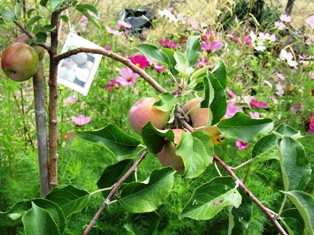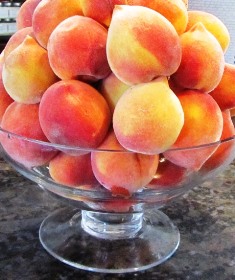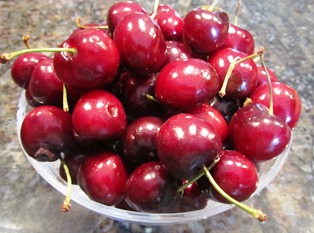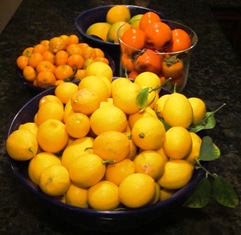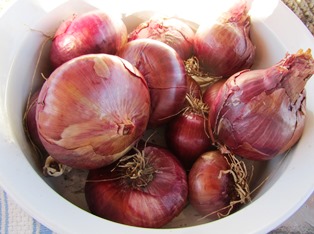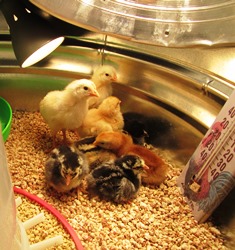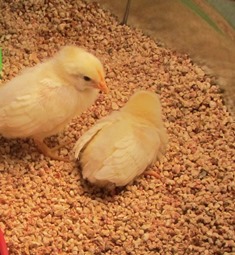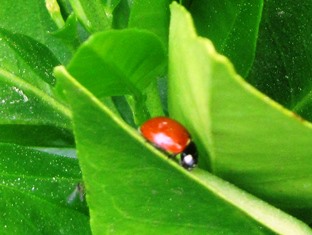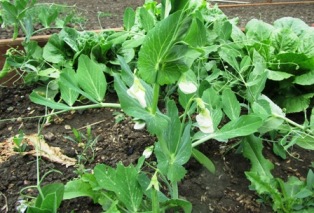Archive for March, 2014
Rooting Plants in Water
I’m a compulsive clipper of plants, knowing that many will send out new roots if placed in a container of water on a window sill. It’s not uncommon for my window sill to fill up with glass jars of cuttings.
With my precious clippings in water, I change the water often to keep it from becoming stagnant.
Among the plants that easily root in water are begonia, coleus, English ivy, geranium, grape ivy, philodendron, pothos, African violet, avocado, and sweet potato.
Several varieties of herbs also root in water: basil, catnip, various kinds of mint, pineapple sage, and watercress.
Bulbs, such as paperwhite narcissus, amaryllis, and hyacinth can be forced to bloom and will also produce roots. Place the base of the bulb on stones or marbles in a dish with water so that the bulb’s base sits on the water’s surface. The roots will grow downward, so you must always ensure there is adequate water.
Take care when putting your cuttings into soil so as not to damage the fragile, newly formed roots. Once you see how easy the process is, you might find your window sill filling up with cuttings in water, too.
California’s Farmers Markets Offer Fresh and Tantalizing Fruits and Berries
Eating fresh means growing it yourself or purchasing the food for your table direct from its source. California farmers’ markets offer a dazzling variety of fruits, vegetables, and nuts directly from local area farmettes, orchards, small and commercial farms, specialty growers, and ranchers.
Many fruits and vegetables are certified organic. That means the farmers and growers are registered and in compliance with state and local regulations designed to protect consumers and ensure food quality and safety.
Annually, California produces nearly half of the nation’s fruits, nuts, and vegetables, according to the California Department of Food and Agriculture. See http://www.cdfa.ca.gov/Statistics/
The San Joaquin Valley of central California has earned the moniker of the World’s Food Basket since its crops account for 12.8 percent of all agricultural products from California.
In fact, California leads the nation in production of figs, dates, plums, melons, nectarines, peaches (Clingstone and Freestone), pears (Bartlett), persimmons, raspberries, and apricots.
In the Golden State, you can find dozens of types of fruits offered at 350 farmers’ markets (some open all year long). For a list by county, see http://www.pcfma.com/markets.php.
From the Pacific Coast Farmer’s Market Association, the following list (recapped below) reveals when these fruits are in season in California.
Apples: January-February; August-December
Apricots: May-July
Blackberries: June-September
Blueberries: May-August
Boysenberries: June-August
Cantaloupe: May-September
Cherries: April-June
Citrus: January-March; November-December
Dates: September-December
Figs: September-November
Grapes: August-November
Kiwi: January-April; October-December
Melons: June-September
Nectarines:May-September
Peaches: May-September
Pears: September-December
Persimmons: September-November
Plums: May-October
Pluots: May-September
Pomegranates: September-November
Prunes: May-September
Raspberries: May-October
Strawberries: February-November
Watermelon: July-September
California’s Agricultural Wealth on Display in Its Farmers’ Markets
California is especially blessed with rich soil and that lovely Mediterranean climate with the near-perfect amount of heat and chilling that our agricultural products require.
You might not know that Northern California leads the nation in production of nearly three dozen different commodities, including artichokes, strawberries, peaches, and walnuts. Many products can be found at local farmers’ markets. See http://www.pcfma.com/
Our state offers more than 350 farmers’ markets and many are year-round. With growing interest in healthy eating as advocated by First Lady Michelle Obama, whose position about the importance of healthier food for kids and their families has been highly publicized, community participation in local farmers’ markets is growing.
Buy fresh and buy local. I love that adage because in practice your dollars spent at farmers’ markets or in direct purchases from farms preserves our farmlands, local growers, and small businesses selling locally grown fruits, vegetables, berries, nuts, and citrus.
The Pacific Coast Farmers’ Market Association has produced a comprehensive listing of agricultural products available in our area for each month of the year. I’ve recapped the list of vegetables here. The fruit and berries will be the subject of a future blog.
Asian Vegetables: January-December
Asparagus: March-June
Beans: January-December
Broccoli: January-December
Brussels sprouts: January-March; September-December
Carrots: January-December
Cauliflower: January-June; October-December
Celery: January-December
Corn: July-September
Cucumber: May-November
Eggplant: May-October
Garlic: January-December
Lettuce: January-December
Mushrooms: January-December
Onions: January-December
Parsnips: January-May; October-December
Peas: April-October
Peppers: May-November
Potatoes: January-December
Spinach: January-December
Squash (summer): May-September
Squash (winter): January-February; October-December
Sweet Potatoes: January; September-December
Tomatoes: May-October
Help preserve California’s rich heritage of plant diversity. Support your local farmers’ market by buying fresh, often just-picked vegetables and fruits, the result of our long growing season and rich soil. You’ll be supporting our state’s farmers and growers.
The Benefits of Bamboo

Bamboo plants make great screens, clipped hedges, or a dramatic foil for plants layered in front of it.
Bamboo plants are favored by environmentalists because they are drought tolerant, can be used for erosion control, are not fussy about soil, make fast-growing hedges or screens, and quickly naturalize.
We grow mainly the clumping type of bamboo because it makes very little horizontal growth and stays tightly clumped. It just gets dense.
The runner type, however, spreads through underground stems that grow out from the rhizome. These are the types of bamboos that reach considerable heights and form groves.
Dividing the plants helps maintain control of these woody-stemmed giant grasses.
Spring is the best time to divide bamboo plants. Although spring is still a few days away, we are dividing the bamboo that thrives along our farmette fences and planting it as a screen on the side of the house where we can see traffic from the road.
Although bamboo has gotten a bad rap for spreading into areas where it isn’t wanted, it can be confined in containers or by inserting metal or concrete barriers into the soil to prevent unwanted invasion by the runner type.
The plant’s evergreen leaves on tall, slender stems look graceful swaying in the breeze and, coupled with its other benefits, make bamboo a good choice for some landscapes.
Chicklet Therapy: Raising Baby Chicks
I’m raising a flock of baby chicks in a tub in my kitchen. Watching them is nothing short of a stress-busting exercise. Not only do they provide endless entertainment, but they already show individual temperaments and personality traits that can’t help but make you smile.
Some people raise backyard chickens for both meat and eggs. Others want only eggs (I’m in that group). And there are those who love keeping the more exotic breeds–imagine feathered legs and toes, cheek muffs, beards, and strange-looking combs.
There are so many breeds, it’s hard to keep track of them all. For example, there are the standards like the White Leghorns and Rhode Island Reds; the exotics like the Faverolles (with their five toes, feathered feet, and fluffy beards and muffs), and heritage chickens.
Traditional breeds or “heritage” chickens aren’t as popular as they once were, so their numbers are declining. Some are even considered Of the heritage chickens whose numbers are declining so rapidly that they are considered globally endangered. They include Campines, Andalusians, Buttercups, Catalanas, Sumatras, and other breeds.
My baby chick choices include a Rhode Island Red, a Buff Orpington, two Silver-Laced Wyandottes, two White Leghorns, a Black Sex Link, and an Ameraucana (who lays blue-green eggs). All are known to be good layers, although some are more productive than others.
Egg production can go down during periods of molting (losing their feathers) or broodiness (sitting on the eggs as though they will hatch, which they won’t because without a rooster, the eggs are not fertile). Also, egg production can decline during winter when the daylight hours are shorter.
The following guidance comes from my local feed and pet supply store, Concord Feed, Pet, and Livestock Supply. See, http://www.concordfeed.com. The store’s capable staff are all extremely knowledgeable about chicks. Here are the guidelines.
1. The environment must be clean, warm, and dry (no drafts). Consider a brooder’s box or large galvanized tub filled with dry and mold-free bedding such as corn cob shavings (Bed-O-Cobb is a good one). Avoid smooth, slick surfaces that can cause leg damage.
2. They must have room to roam. The rule of thumb is 1 square foot per chick; when they are six weeks and older, given them 2 square feet per bird.
3. Day-old chicks need 90 to 95 degrees Fahrenheit. To achieve this, attach a heat lamp or light bulb about 20 inches above the chicks. When cold, the baby chicks tend to huddle together under the lamp for warmth; when hot, the chicks move to the corners. You will want to reduce the temperature created by the heat lamp by five degrees each week until you reach the ideal temperature of 65 degrees Fahrenheit. Simply move the lamp further away from the chicks.
4. Hydrate the chicks with a one-quart of fresh, cool water in a dispenser that is changed daily (or more often if they scratch bedding or food into it). A quart container will provide enough water for 25 chicks.
5. Feed the babies with a chick starter until they are 16 to 20 weeks old. By that age, they should be feathered completely. Then begin giving the hens a laying feed to help them produce strong-shelled eggs and provide them with the nutrients they require.
By following these guidelines, I think I’ll be able to have eggs from my little hens by August or September this year, barring any of them turning out to be roosters. In case I must give him up (some cities don’t allow roosters), which I wouldn’t want to do, I’ve already talked to the feed store about rooster rescue organization. For helpful information about keeping chickens, see http://www.backyardchickens.com/
Have You Planned Your Garden Yet?
Ladybugs and honeybees occasionally meet on the same leaf when both forage for food. The ladybugs dine on aphids while the honeybees seek the sweet nectar of blossoms; orange, tangerine, and lime trees are favorites.
The bug and bee traffic has been steadily increasing now that showers and warm weather have triggered blossoms opening on the fruit and citrus trees around the farmette.
Spring doesn’t officially begin until March 20, but with the weather forecasters predicting upper 70’s Fahrenheit later this week and nighttime temperatures in the 50’s, it is time to consider options for your garden. Many DIY centers are already offering vegetable seedlings, herbs, and berries for planting. Some have markedly discounted their bare-root fruit trees and roses.
I’ve already planted seeds in flats for germination and scattered flower seed (collected from last summer’s flower garden) around prepared beds. When the outside temperatures start to climb, I’ll be rewarded with blooms from nasturtiums, petunias, zinnias, and sunflowers.
The climbing roses are already past the red-leaf stage and are producing the first flush of blooms for spring. The wisteria vines have plump pods ready to unfurl with gorgeous tracts of purple blossoms. And the first green tips of leaves are beginning to sprout on my apples even as the early peaches and apricots already have fruit forming.
This time of year holds the promise of new beginnings, and you see that in every step you take in a garden. Because I prefer to grow plants from varieties of heirloom, open-pollinated seed, I save it from the best specimens grown in the previous season. Of course, some plants freely re-seed themselves. That’s why I now find lettuce and onions and even sweet peas coming up in expected places on the property.
Have you figured out what veggies, flowers, fruits, and berries you’ll plant and grow in your garden this year? If not, now’s a good time to get started. For ideas, check out, http://www.organicgardening.com/learn-and-grow/plan-beautiful-vegetable-garden.
If you prefer, as I do, the non-GMO and organic seeds, there are many excellent sources for them. For heirloom and rare seed, check out http://www.rareseeds.com/store/vegetables/. Also see, http://www.victoryseeds.com/aboutus.html and http://www.anniesheirloomseeds.com/
 Facebook
Facebook Goodreads
Goodreads LinkedIn
LinkedIn Meera Lester
Meera Lester Twitter
Twitter






